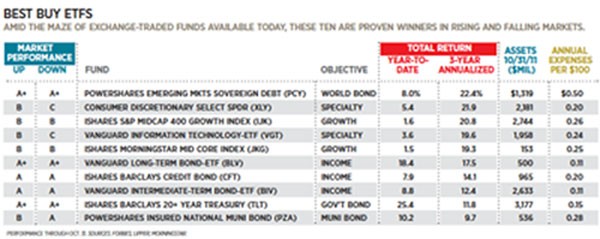Why Invest with ETFs A Beginner s Guide to ETF Investing
Post on: 16 Март, 2015 No Comment

by Admin on March 11, 2009 | Updated December 8, 2014
An ETF is an exchange-traded fund. For simplicitys sake, you can think of it as a mutual fund that trades like a stock. An ETF is bought and sold on an intraday securities exchange and is composed of a basket of securities. Generally, ETFs will trade at (or very close to) the same price of the net asset value of the underlying assets. Most ETFs are index funds that track indices such as the S&P 500, Russell 1000, or MSCI, just to name a few. In 2008, however, the Securities and Exchange Commission began authorizing the creation of actively-managed ETFs.
How Individual Investors Win: Buy the Market and Keep Costs Low
It is very difficult to beat the market picking individual stocks or investing in an actively-managed mutual fund (especially after incurring the fees associated with both). So with investing, its usually best to live by the maxim: If you cant beat em, join em. The fact is that youre not likely to beat the market. But you can match the market with index ETFs.
Advantages of ETFs over Picking Individual Stocks
ETFs have the same basic advantage that mutual funds do when compared to picking individual stocks: diversification. And thats exactly what every investor needs. Over the long run, diversification reduces risk without impacting returns. Say youre a fan of a particular sector and would like to invest in its future. You could try your hand at picking stocks of a few companies within that sector. A better strategy would be to buy an ETF that tracks the sectors index. This way, youre protected against the volatility that a few companies within the sector may be subject to. Further, youre only making one transaction, instead of several, saving you on brokerage fees.
Advantages of ETFs over Actively-Managed Mutual Funds

It turns out that mutual fund managers are not that different from the average investor: most of them do not beat the market. The fact that most ETFs are indexed, therefore, ensures that they will on average perform better than actively-managed mutual funds. Additionally, there are several other ways in which exchange-traded funds beat out mutual funds.
- Expense ratios are much lower. Actively-managed mutual funds incur a management fee that can sometimes be more than 2.00%. Also, most ETFs do not have 12b-1 fees. ETF expense ratios are typically in the 0.25% 0.75% range.
- No investment minimums. While mutual funds may often have minimums as high as $1,000, $5,000, or more, ETFs can be bought or sold in as little as one-share increments.
- Option and Short-selling opportunities. Because ETFs are traded on a securities exchange throughout the day, the opportunities for option and short-selling exist.
- Lower taxes. Actively-managed mutual funds are subject to much higher turnover than ETFs. Therefore, tax gain distributions are much more frequent with mutual funds.
- More trading flexibility. Mutual funds are only priced once per day, at the close of the market. Conversely, ETFs are priced throughout the day and can be bought and sold on the exchange.
- More transparency. ETFs are completely transparent. Investors can see exactly which securities are held in each ETF. Actively-managed mutual funds do not provide holdings to their investors.
Advantages of ETFs over Index Funds
Index ETFs clearly have the upper hand over actively-managed mutual funds. But how do they stack up with their index mutual fund (index fund) counterparts? Index funds are not actively managed, and their expense ratios are much lower than actively-managed mutual funds. Thus, index funds are still a reasonable way to buy the market and keep management and trading costs low. Many investors however opt for ETFs over index funds, since ETFs have no investment minimums, may be traded intra-day and are generally considered more convenient.














